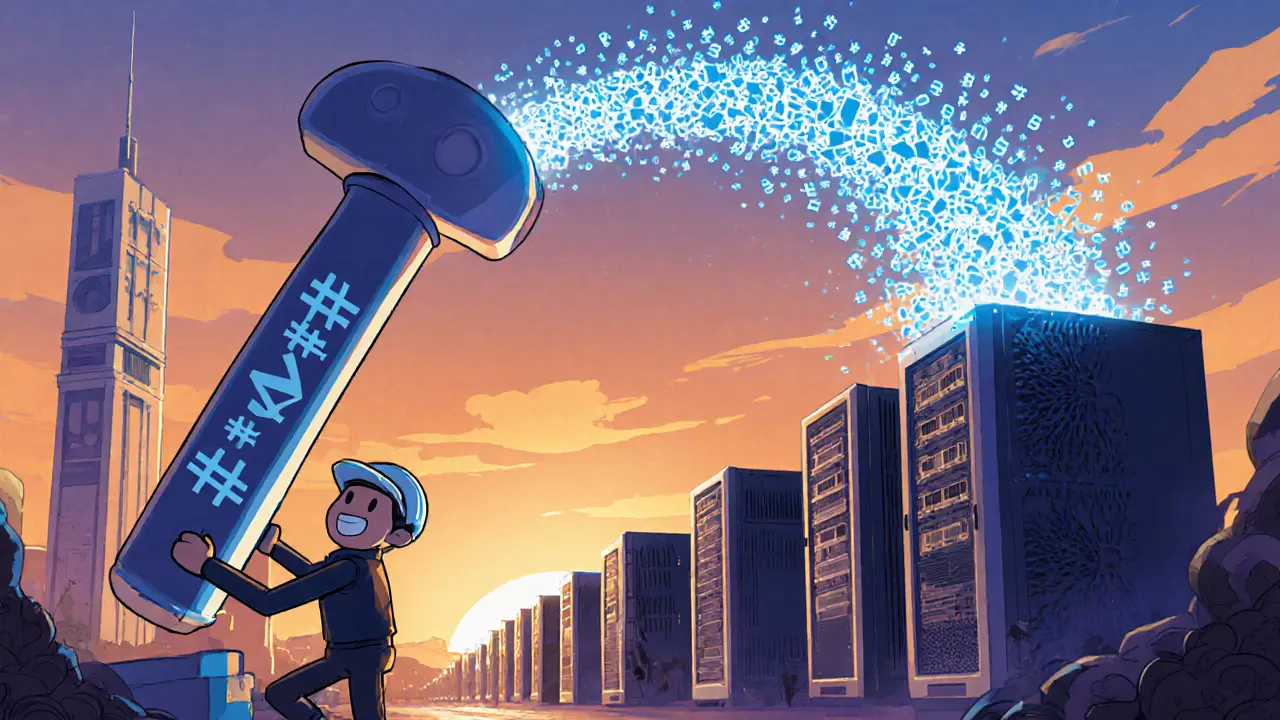Mining Profitability Calculator
Calculate Your Mining Profitability
Estimate your daily earnings based on your equipment, electricity costs, and current market conditions.
Estimated Daily Profit
How This Calculator Works
This calculator uses data from the article to estimate your daily mining profitability based on your specific inputs. It considers:
- Hardware efficiency (J/TH)
- Electricity costs
- Current block reward and transaction fees
- Pool fees
For reference, the calculator uses data from the AntMiner S21e XP Hyd (860 TH/s, 11,180 W) as the default hardware option.
Mining a cryptocurrency looks easy when you see a flashing "Earn" button, but the reality is a balance of power, cost, and market forces. Grasping the hash rate and knowing how it feeds into mining profitability lets you decide whether a mining operation is a smart investment or a costly hobby.
What is Hash Rate?
Hash Rate measures how many hash calculations a miner (or the whole network) can perform each second. It’s expressed in hashes per second (H/s) and scales up to terahashes (TH/s) and petahashes (PH/s). When Bitcoin launched in 2009, the network hash rate was a few megahashes per second. By October 2024 it had exploded to around 690 exahashes per second (EH/s), a rise of more than 13,000 % since 2019.
Higher hash rate means a miner submits more guesses at the solution to the proof‑of‑work puzzle, which improves the chance of winning the next block reward. However, every extra TH/s comes with a power draw and capital outlay.
Defining Mining Profitability
Mining Profitability answers the simple question: does the revenue from block rewards and transaction fees exceed the total cost of running the hardware? Costs include electricity, hardware depreciation, pool fees, and any cooling or facility expenses. If the answer is yes, the miner contributes to network security while earning a net profit.
Why Hash Rate Drives Profitability
Every block on a proof‑of‑work chain requires a valid hash. The probability of finding that hash is directly proportional to the miner’s share of the total hash rate. A miner controlling 1 % of the global hash rate can expect roughly 1 % of the daily block rewards, assuming identical efficiency.
When the Bitcoin halving on 20 April 2024 cut the reward from 6.25 BTC to 3.125 BTC, miners lost half of their revenue overnight. The network’s total hash rate dipped 19.3 % right after the halving before climbing back as efficiency‑focused miners entered the field. This illustrates how a sudden drop in block reward forces the whole ecosystem to adjust its hash rate to stay profitable.
Key Variables That Influence Profitability
- Network Difficulty: Adjusted roughly every two weeks to keep block times constant. Higher difficulty means you need more hash power for the same reward.
- Block Reward & Transaction Fees: Rewards drop on halving events; fees can rise when transaction volume spikes.
- Electricity Cost: The biggest recurring expense. In Q2 2024 the average U.S. commercial rate was $0.1178 /kWh, while hydro‑powered sites in Iceland enjoy rates below $0.03 /kWh, dramatically widening profit margins.
- Hardware Efficiency: Measured in joules per terahash (J/TH). Modern ASICs like Bitmain’s AntMiner S21e XP Hyd hit 12.9 J/TH, a 30 % improvement over 2023 models.
- Capital Expenditure: High‑end ASICs can cost $6,000 each; GPUs are cheaper but offer far less hash power per dollar.

Hardware Showdown: ASIC vs GPU vs CPU
| Hardware | Hash Rate (TH/s) | Power (W) | Daily BTC | Daily $ (USD) |
|---|---|---|---|---|
| AntMiner S21e XP Hyd | 860 | 11,180 | 0.000415 | 34.45 |
| NVIDIA RTX 4090 (GPU) | 0.12 | 450 | 0.000006 | 0.50 |
| AMD Threadripper 3990X (CPU) | 0.015 | 280 | 0.000014 | 1.16 |
The table makes the gap clear: a single high‑end ASIC can out‑earn a whole GPU rig by more than 60 times on a per‑day basis, even after accounting for higher electricity draw.
Real‑World Profitability Snapshots (2024‑2025)
Using the Jason Blevins Bitcoin Mining Profit Calculator, a 860 TH/s AntMiner S21e XP Hyd in a location with $0.05 /kWh electricity yields roughly $34.45 per day, or $12,580 per year before maintenance. In contrast, a GPU miner in the same region brings in just $0.50 daily, barely covering power costs.
Power costs are the decisive factor. An operator in Texas paying $0.06 /kWh keeps a positive margin, while one paying $0.12 /kWh sees a 40 % margin compression after the 2024 halving, as noted by JPMorgan’s chief mining economist Lee Reiswig.
Renewable‑energy‑backed farms in Iceland or the Yukon demonstrate the biggest advantage. With electricity at $0.03 /kWh, the same AntMiner model can deliver more than $70 daily profit, pushing annual ROI above 30 %.
Strategies to Boost Mining Profitability
- Locate Cheap Power: Target regions with industrial‑scale renewable sources, waste‑heat recovery, or excess natural gas flares. Prices under $0.06 /kWh are considered “sweet spots.”
- Upgrade Efficiency: Newer ASICs cut joules per terahash by 20‑30 %. Aim for sub‑10 J/TH devices to future‑proof against rising difficulty.
- Join a Low‑Fee Pool: Pool fees range from 0 % to 3 %. Lower fees directly improve net revenue.
- Leverage Tax Incentives: Some U.S. states offer tax breaks for renewable‑energy mining; Texas provides 0 % corporate tax for qualified facilities.
- Monitor Difficulty Trends: Use tools like CryptoCompare’s difficulty tracker. If projected difficulty growth exceeds 80 % annually, reconsider expanding hash power.

Future Outlook: Difficulty, Halvings, and Regulation
Bitcoin’s difficulty is expected to reach 1.47 × 10¹⁴ by the end of 2025, according to Blevins’ model. Maintaining profitability will therefore demand hardware that hits double‑digit joules‑per‑terahash efficiencies.
Regulatory pressure is rising. The EU’s MiCA framework adds a 20 % energy tax on PoW mining from January 2025, nudging miners toward low‑cost green energy or out‑of‑region relocation. In the U.S., New York’s two‑year moratorium on new PoW facilities still squeezes East‑Coast operators.
Despite these challenges, institutions like Marathon Digital Holdings and Riot Platforms are scaling up, controlling over 13 EH/s combined. Their economies of scale allow them to absorb higher electricity rates and still turn a profit, signaling that large‑scale mining remains viable.
Profitability Checklist for Prospective Miners
- Calculate estimated daily revenue using up‑to‑date block reward, difficulty, and BTC price.
- Plug your electricity rate into a profitability calculator (e.g., NiceHash).
- Compare hardware options: ASIC efficiency vs upfront cost vs expected lifespan.
- Factor in cooling, facility rent, and maintenance overhead (average repair cost $287 per ASIC).
- Run a break‑even analysis: at what kWh price does your ROI hit zero?
- Check local regulations and potential tax implications.
Frequently Asked Questions
What does a higher hash rate mean for an individual miner?
A higher hash rate raises the miner’s share of the total network power, which directly increases the chance of winning block rewards. However, it also usually means higher electricity consumption and greater capital cost.
How can I estimate if my mining setup will be profitable?
Enter your hardware’s hash rate, power draw, electricity price, and pool fee into a calculator like NiceHash or CryptoCompare. The tool will output daily net profit and the break‑even electricity cost.
Why did the Bitcoin network hash rate drop after the 2024 halving?
The halving cut block rewards in half, slashing revenue for miners. Those with high electricity costs or inefficient hardware could no longer cover expenses, so they temporarily shut down, causing a dip in total hash rate.
Is GPU mining still worth it in 2025?
For Bitcoin, no-ASICs dominate 99.8 % of the hash rate. GPU mining can still be profitable on altcoins that use GPU‑friendly algorithms (e.g., Ravencoin’s KawPow), but you must compare the specific coin’s difficulty and price.
How much electricity does an AntMiner S21e XP Hyd consume per day?
At 11,180 W, the unit uses about 268.3 kWh per day (11,180 W × 24 h ÷ 1,000). At $0.05 /kWh that’s roughly $13.42 in power costs daily.

7 Comments
Wayne Overton
ASICs are just power hungry monsters. Why not just buy BTC instead of burning electricity?
Alisa Rosner
I love this breakdown! 🙌 Seriously, if you're thinking about mining, DO NOT skip the electricity cost calc. I used NiceHash and found out my home setup would lose me $12/day 😱. Switched to staking instead-way less stress! 💡⚡
MICHELLE SANTOYO
So we're just glorified digital coal miners now? Mining Bitcoin is the new industrial revolution... or is it just capitalism feeding on its own tail? 🤔 The planet burns, we count hashes, and someone in a suit calls it "innovation."
Lena Novikova
GPU mining is dead for BTC period. End of story. You think you're saving money with an RTX 4090? Bro you're paying to run a space heater that occasionally blinks green. ASICs aren't optional they're mandatory. Stop wasting your time
Olav Hans-Ols
Really cool breakdown! I've been eyeing a used S21 for a while now. The Iceland thing is wild-imagine mining while watching the northern lights. 🌌 Maybe I'll move there someday. Anyone know if they let foreigners set up rigs?
Kevin Johnston
This is gold 🏆 Just saved my $2k from buying a useless GPU rig. Hash rate + power cost = REAL profit. Thanks for the clarity! 💪🔥
Dr. Monica Ellis-Blied
The fundamental flaw in this entire narrative is the assumption that profitability equals sustainability. You've outlined the mechanics, but ignored the ethical calculus: Is it morally defensible to consume the equivalent of a small nation's energy to validate a speculative asset? The EU’s MiCA tax is not a burden-it is a necessary correction. Mining must evolve, or it will be abandoned-not by market forces, but by conscience.